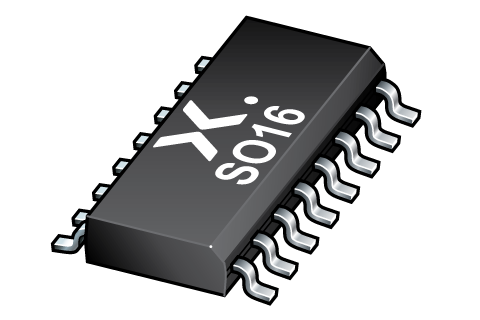
Register once, drag and drop ECAD models into your CAD tool and speed up your design.
Click here for more information74HC158D
Quad 2-input multiplexer; inverting
The 74HC is a high-speed Si-gate CMOS device and is pin compatible with low power Schottky TTL (LSTTL). The 74HC158 is specified in compliance with JEDEC standard no. 7A.
The 74HC158 is a quad 2-input multiplexer which select 4 bits of data from two sources and are controlled by a common data select input (S). The four outputs present the selected data in the inverted form. The enable input (E) is active LOW.
When E is HIGH, all the outputs (1Y to 4Y) are forced HIGH regardless of all other input conditions.
Moving the data from two groups of registers to four common output buses is a common use of the 74HC158. The state of S determines the particular register from which the data comes. It can also be used as a function generator.
The device is useful for implementing highly irregular logic by generating any four of the 16 different functions of two variables with one variable common.
The 74HC158 is the logic implementation of a 4-pole, 2-position switch, where the position of the switch is determined by the logic levels applied to S.
The logic equations for the output are:
1Y = E·(1l1·S + 1l0· S)
2Y = E·(2l1·S + 2l0· S)
3Y = E·(3l1·S + 3l0· S)
4Y = E·(4l1·S + 4l0· S)
The 74HC158 is identical to the 74HC157 but has inverting outputs.
Features and benefits
Low-power dissipation
Inverting data path
Complies with JEDEC standard no. 7A
ESD protection:
HBM JESD22-A114F exceeds 2 000 V
MM JESD22-A115-A exceeds 200 V
Multiple package options
Specified from -40 °C to +80 °C and from -40 °C to +125 °C
Applications
Parametrics
| Type number | Package name |
|---|---|
| 74HC158D | SO16 |
PCB Symbol, Footprint and 3D Model
| Model Name | Description |
|---|---|
|
|
Package
All type numbers in the table below are discontinued.
| Type number | Orderable part number, (Ordering code (12NC)) | Status | Marking | Package | Package information | Reflow-/Wave soldering | Packing |
|---|---|---|---|---|---|---|---|
| 74HC158D | 74HC158D,652 (933713760652) |
Obsolete |

SO16 (SOT109-1) |
SOT109-1 |
SO-SOJ-REFLOW
SO-SOJ-WAVE WAVE_BG-BD-1 |
SOT109-1_652 | |
| 74HC158D,653 (933713760653) |
Obsolete | Not available |
Environmental information
All type numbers in the table below are discontinued.
| Type number | Orderable part number | Chemical content | RoHS | RHF-indicator |
|---|---|---|---|---|
| 74HC158D | 74HC158D,652 | 74HC158D |
|
|
| 74HC158D | 74HC158D,653 | 74HC158D |
|
|
Documentation (11)
| File name | Title | Type | Date |
|---|---|---|---|
| 74HC158 | Quad 2-input multiplexer; inverting | Data sheet | 2017-07-20 |
| AN11044 | Pin FMEA 74HC/74HCT family | Application note | 2019-01-09 |
| AN90063 | Questions about package outline drawings | Application note | 2025-03-12 |
| SOT109-1 | 3D model for products with SOT109-1 package | Design support | 2020-01-22 |
| Nexperia_package_poster | Nexperia package poster | Leaflet | 2020-05-15 |
| SO16_SOT109-1_mk | plastic, small outline package; 16 leads; 1.27 mm pitch; 9.9 mm x 3.9 mm x 1.35 mm body | Marcom graphics | 2017-01-28 |
| SOT109-1 | plastic, small outline package; 16 leads; 1.27 mm pitch; 9.9 mm x 3.9 mm x 1.75 mm body | Package information | 2023-11-07 |
| SO-SOJ-REFLOW | Footprint for reflow soldering | Reflow soldering | 2009-10-08 |
| HCT_USER_GUIDE | HC/T User Guide | User manual | 1997-10-31 |
| SO-SOJ-WAVE | Footprint for wave soldering | Wave soldering | 2009-10-08 |
| WAVE_BG-BD-1 | Wave soldering profile | Wave soldering | 2021-09-08 |
Support
If you are in need of design/technical support, let us know and fill in the answer form we'll get back to you shortly.
Longevity
The Nexperia Longevity Program is aimed to provide our customers information from time to time about the expected time that our products can be ordered. The NLP is reviewed and updated regularly by our Executive Management Team. View our longevity program here.
Models
| File name | Title | Type | Date |
|---|---|---|---|
| SOT109-1 | 3D model for products with SOT109-1 package | Design support | 2020-01-22 |
PCB Symbol, Footprint and 3D Model
| Model Name | Description |
|---|---|
|
|
How does it work?
The interactive datasheets are based on the Nexperia MOSFET precision electrothermal models. With our interactive datasheets you can simply specify your own conditions interactively. Start by changing the values of the conditions. You can do this by using the sliders in the condition fields. By dragging the sliders you will see how the MOSFET will perform at the new conditions set.